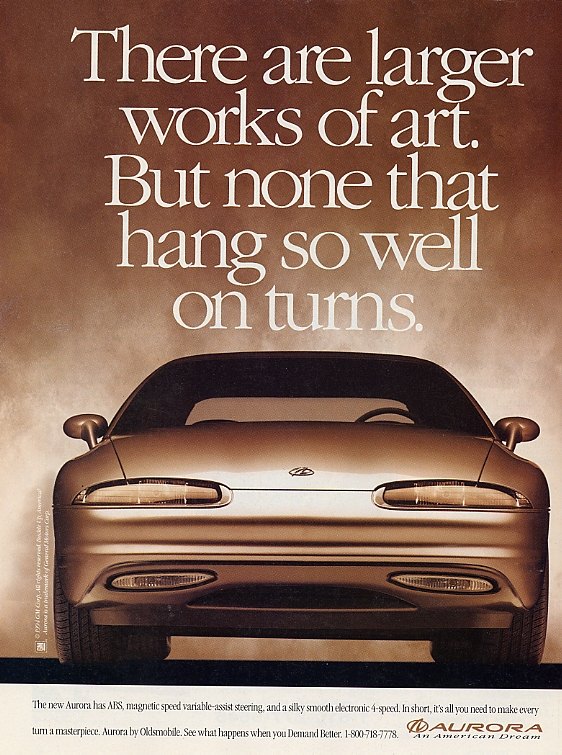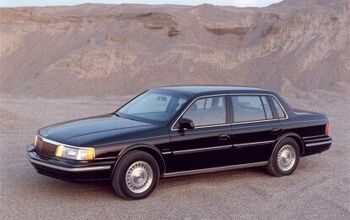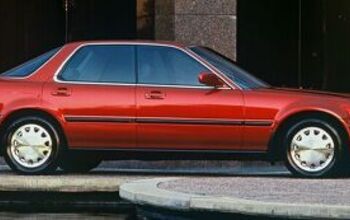Buy/Drive/Burn: Alternative Luxury Sedans Hailing From 1995

The B&B has proved on many occasions that they enjoy a nice Buy/Drive/Burn or three centered around the 1990s. I sense you want more, so have more! Today’s trio sprang to mind as we discussed the article surrounding Buick’s choice to remove the brand name from all new vehicles. In the comments, things naturally turned to the Oldsmobile Aurora and the modified Rocket logo it displayed.
But what other two vehicles from 1995 do you pair with the brand new Oldsmobile Aurora? Will you want to burn any of these? Let’s find out.
Oldsmobile Aurora
First, the one you knew was coming. 1995 was the introductory model year for the Aurora. An all-new styling direction for the brand, the sleek sedan was de-badged and decidedly distant from things like the staid Ninety-Eight and its Regency Elite Grandpa Deluxe trim (which remained in production through ’96). Riding on GM’s G platform with the Buick’s Riviera, the Aurora was a unique offering and did not have a GM-branded counterpart. It’s motivated by a 4.0-liter L47 V8, based on Cadillac’s Northstar 4.6. The engine was designed especially for the new Aurora flagship. 250 horsepower travels to the front wheels through a four-speed automatic. Leather, dual-zone climate control, and real wood trim are at your fingertips. As an added bonus, it doesn’t look like anything else on the road in 1995. It would be the last all-new Oldsmobile developed by Oldsmobile.
Volvo 960
The 960 was Volvo’s flagship entry into the world market throughout the 1990s. Introduced in the United States for 1991, the rear-drive 960 would start out with several different engines including an awful PRV V6 of 2.8 liters. Thankfully Volvo developed their own engines, and the ’95 960 has a much better 2.9-liter I6 under the hood. A steady 178 horsepower are available through the 4-speed automatic. Built in Sweden, the boxy 960 would be the last rear-drive car built by Volvo. The 960 received no direct replacement after sales ended in 1998.
Saab 9000
Rounding out our trio of alternative last-of luxury is the shapely 9000 from Saab. Easily the oldest design here, the 9000 debuted all the way back in 1985. The Giugiaro design went through some modernization throughout the years, entering its final design iteration in 1994. For 1995, the CDE (sedan) version of the 9000 was equipped with a 3.0-liter GM-Opel V6 engine that would also see duty in the Cadillac Catera and early Saturn Vue. 1995 was the only year for this V6, as afterward only turbocharged four-cylinder engines were available. 208 horsepower travel to the front wheels via the four-speed auto. The 9000 would be the last pure Saab-developed sedan in production, as the replacement 9-5 for 1999 was very much a GM-sourced vehicle.
So, which of these sad last-of items gets burned at the stake, and which do you take home with you?
[Images: General Motors, Wikimedia ( CC BY-SA 3.0), ]

Interested in lots of cars and their various historical contexts. Started writing articles for TTAC in late 2016, when my first posts were QOTDs. From there I started a few new series like Rare Rides, Buy/Drive/Burn, Abandoned History, and most recently Rare Rides Icons. Operating from a home base in Cincinnati, Ohio, a relative auto journalist dead zone. Many of my articles are prompted by something I'll see on social media that sparks my interest and causes me to research. Finding articles and information from the early days of the internet and beyond that covers the little details lost to time: trim packages, color and wheel choices, interior fabrics. Beyond those, I'm fascinated by automotive industry experiments, both failures and successes. Lately I've taken an interest in AI, and generating "what if" type images for car models long dead. Reincarnating a modern Toyota Paseo, Lincoln Mark IX, or Isuzu Trooper through a text prompt is fun. Fun to post them on Twitter too, and watch people overreact. To that end, the social media I use most is Twitter, @CoreyLewis86. I also contribute pieces for Forbes Wheels and Forbes Home.
More by Corey Lewis
Latest Car Reviews
Read moreLatest Product Reviews
Read moreRecent Comments
- Redapple2 4 Keys to a Safe, Modern, Prosperous Society1 Cheap Energy2 Meritocracy. The best person gets the job. Regardless.3 Free Speech. Fair and strong press.4 Law and Order. Do a crime. Get punished.One large group is damaging the above 4. The other party holds them as key. You are Iran or Zimbabwe without them.
- Alan Where's Earnest? TX? NM? AR? Must be a new Tesla plant the Earnest plant.
- Alan Change will occur and a sloppy transition to a more environmentally friendly society will occur. There will be plenty of screaming and kicking in the process.I don't know why certain individuals keep on touting that what is put forward will occur. It's all talk and BS, but the transition will occur eventually.This conversation is no different to union demands, does the union always get what they want, or a portion of their demands? Green ideas will be put forward to discuss and debate and an outcome will be had.Hydrogen is the only logical form of renewable energy to power transport in the future. Why? Like oil the materials to manufacture batteries is limited.
- Alan As the established auto manufacturers become better at producing EVs I think Tesla will lay off more workers.In 2019 Tesla held 81% of the US EV market. 2023 it has dwindled to 54% of the US market. If this trend continues Tesla will definitely downsize more.There is one thing that the established auto manufacturers do better than Tesla. That is generate new models. Tesla seems unable to refresh its lineup quick enough against competition. Sort of like why did Sears go broke? Sears was the mail order king, one would think it would of been easier to transition to online sales. Sears couldn't adapt to on line shopping competitively, so Amazon killed it.
- Alan I wonder if China has Great Wall condos?





































Comments
Join the conversation
Buy the Volvo, drive the Olds and what is the Saab doing in this comparison anyway ?
Buy the Volvo (soft spot for the old boxes) Drive the Saab... More HP Burn the Olds ... Complete GM plastic 90s suck-atude. Someone mentioned a Chrysler LHX.... UUgh... Horrible trash